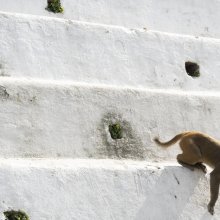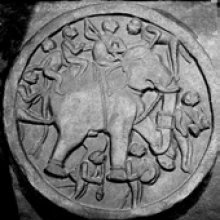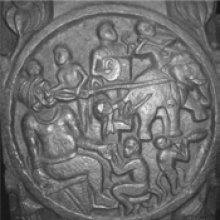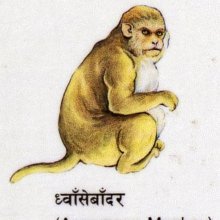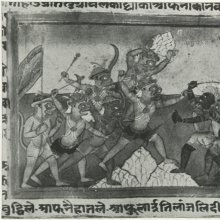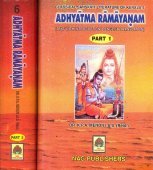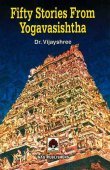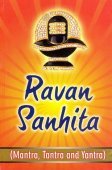Monkey: 2 definitions
Introduction:
Monkey means something in Hinduism, Sanskrit. If you want to know the exact meaning, history, etymology or English translation of this term then check out the descriptions on this page. Add your comment or reference to a book if you want to contribute to this summary article.
Images (photo gallery)
(+18 more images available)
In Hinduism
Natyashastra (theatrics and dramaturgy)
Source: Shodhganga: Elements of Art and Architecture in the Trtiyakhanda of the Visnudharmottarapurana (natya)The Monkey is denoted by the Sanskrit term Kapi, whereas Kapittha-hasta refers to one of the twenty-two Single-hand Gestures (in Indian Dramas) (known as asaṃyuktahastas), according to the Viṣṇudharmottarapurāṇa, an ancient Sanskrit text which (being encyclopedic in nature) deals with a variety of cultural topics such as arts, architecture, music, grammar and astronomy.—In the Śabdakalpadruma, the word kapittha is explained as a kind of tree where kapi i.e., monkey comes due to the greed of fruit. The word kapittha again denotes the fruit called wood apple. Abhinavagupta states that due to the shape of a wood apple, this posture is named as kapittha. According to the Viṣṇudharmottarapurāṇa, in kapitthahasta, the thumb is inside the fist.

Natyashastra (नाट्यशास्त्र, nāṭyaśāstra) refers to both the ancient Indian tradition (shastra) of performing arts, (natya—theatrics, drama, dance, music), as well as the name of a Sanskrit work dealing with these subjects. It also teaches the rules for composing Dramatic plays (nataka), construction and performance of Theater, and Poetic works (kavya).
Shilpashastra (iconography)
Source: Shodhganga: Elements of Art and Architecture in the Trtiyakhanda of the Visnudharmottarapurana (shilpa)The Monkey is associated with the time of Dawn, and follows specific guidelines of ancient Indian Painting (citra), according to the Viṣṇudharmottarapurāṇa, an ancient Sanskrit text which (being encyclopedic in nature) deals with a variety of cultural topics such as arts, architecture, music, grammar and astronomy.—In the Viṣṇudharmottarapurāṇa, the rules of Painting of different classes have been elaborately discussed. The time of uṣā i.e., dawn when the sun is about to rise. It seems to be a beautiful source of Painting. The picture of a dawn is said to have the people who are eager to do their work and also have a monkey. [...]. Thus the Viṣṇudharmottarapurāṇa establishes the fact that even in the pictures; the people belonging to different class and profession [e.g., monkeys] were projected with specific attire so that general people can equate the picture with the practical character.

Shilpashastra (शिल्पशास्त्र, śilpaśāstra) represents the ancient Indian science (shastra) of creative arts (shilpa) such as sculpture, iconography and painting. Closely related to Vastushastra (architecture), they often share the same literature.
See also (Relevant definitions)
Starts with: Monkey apple, Monkey bone, Monkey bread, Monkey bread tree, Monkey bread tree of africa, Monkey fingers, Monkey fruit, Monkey jack, Monkey ladder, Monkey orange, Monkey peach, Monkey plum, Monkey pod, Monkey rope, Monkey soap, Monkey tail, Monkey tooth, Monkeynut, Monkeypot nuts.
Ends with: Monkey bone, Monkey tooth.
Full-text (+861): Vanara, Markata, Hanuman, Kapeya, Sugriva, Kapi, Shakhamriga, Kisa, Plavanga, Vanari, Kutharu, Kushaksha, Valimukha, Angada, Panasa, Kushaku, Latamriga, Golangula, Langulin, Vrikshacara.
Relevant text
Search found 209 books and stories containing Monkey; (plurals include: Monkeys). You can also click to the full overview containing English textual excerpts. Below are direct links for the most relevant articles:
The Mahavastu (great story) (by J. J. Jones)
Chapter IV - The Jātaka of the monkey (vānara), version 2 < [Volume III]
Chapter III - The Jātaka of the monkey (vānara), version 1 < [Volume III]
Chapter XXV - Jātaka of the Monkey (Markaṭa) < [Volume II]
The Jataka tales [English], Volume 1-6 (by Robert Chalmers)
Jataka 404: Kapi-jātaka < [Volume 3]
Jataka 177: Tiṇḍuka-jātaka < [Book II - Dukanipāta]
Jataka 407: Mahākapi-jātaka < [Volume 3]
Ramayana of Valmiki (by Hari Prasad Shastri)
Chapter 65 - The Leaders of the Monkeys < [Book 4 - Kishkindha-kanda]
Chapter 45 - The Departure of the Monkeys < [Book 4 - Kishkindha-kanda]
Chapter 97 - The Fight between Virupaksha and Sugriva < [Book 6 - Yuddha-kanda]
Tibetan tales (derived from Indian sources) (by W. R. S. Ralston)
Chapter 42 - The Monkeys saved from death
Chapter 45 - The Monkeys and the Moons
Ramayana (by Manmatha Nath Dutt)
Chapter XVII < [Book 1 - Bāla-kāṇḍa]
Chapter I < [Book 1 - Bāla-kāṇḍa]
Chapter III < [Book 1 - Bāla-kāṇḍa]
The Shiva Purana (by J. L. Shastri)
Chapter 20 - The Incarnation of Hanūmat and his story < [Section 3 - Śatarudra-saṃhitā]
Chapter 31 - The greatness of Rāmeśvara < [Section 4 - Koṭirudra-Saṃhitā]
Chapter 3 - Nārada attends the Svayaṃvara of a virgin and is discomfited < [Section 2.1 - Rudra-saṃhitā (1): Sṛśṭi-khaṇḍa]
Related products

